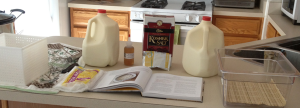
Ingredients and Tools for making Crescenza
It’s been over a month since I made a cheese. I missed not having cheese that I made around to offer people, but then again, I was traveling a great deal in September and it just didn’t make sense to try to make a cheese on the rare weekend I was home. Actually I thought I was going to make this one in August, but I forgot to order all the milk I needed so it didn’t happen.
A Crescenza is also known as a Stracchino, a fresh Italian cheese that is briefly brined. While easy to make, it takes a long time. 11 hours. Not 11 hours of actual work, but every few hours, something needed to be done. I started this cheese at 11:30 am and finished it at 10:30pm. I would have started earlier, but I had to drive to the farm to pick up my fall/winter meat order (50 pounds of beef and a whole lamb including the liver, kidneys and heart, I’m definitely going to have to blog about cooking the organs, something I don’t have a lot of experience with).
This cheese uses 2 gallons of cow’s milk, rennet, Aroma B culture and kosher salt. It also uses a Tallegio cheese mold, which is huge. When I received the mold, I thought it was a mistake. Most molds I have purchased are fairly small. Not this one though. But then again 2 gallons of milk will produce about 2 pounds of cheese. And it fit into the drainer, so I went ahead and used it.
The beginning of any cheese making is basically the same. Make sure your kitchen and equipment is sterilized. I do this by washing all my equipment and wiping everything down with a bleach solution. After that its heating the milk to a certain temperature (in this case 90 degrees), culturing it and allowing it to sit (30 minutes), then incorporating rennet and allowing it to rest again (45 minutes). After this I cut the curds, let them sit and then stir gently to firm them up.
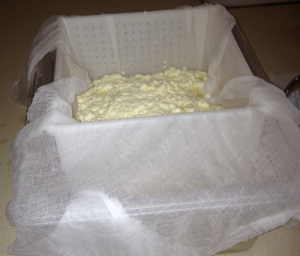
Cheese Curds in a Tallegio Mold
The curds get gently ladled into the cheese cloth-covered mold and then drained for 2 sets of three hours. Within 10 minutes of ladling the curds into the mold, the drainer was filling up fast with whey. So I ended up using a turkey baster to get rid of the whey (if I kept it in there, it would have impeded the draining process).
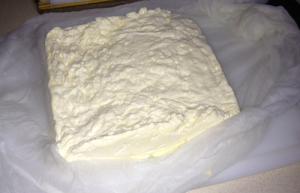
Crescenza Cheese after first half of draining
After the first three hours, I had to flip the cheese. So I removed the cheese cloth and cheese from the mold and then flipped it over, replacing it in the mold and drainer. Wow, that thing was heavy. I make small batches of cheese, I can’t even imagine how someone who was making a larger cheese then this would flip it at this point without breaking the curds.
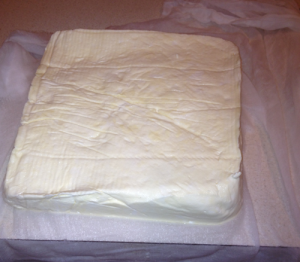
After 6 hours of draining, the cheese has firmed up considerably. While many pictures of Crescenza seem pure white, I’m pretty sure that is because of the milk that they are using. The milk I use for all my cheeses is raw and full of milk fats. So my cheeses usually have a yellowish tinge to them. Now comes the brining.

Brining the Cheese
This cheese is brined in a solution of 5 parts water, 1 part salt. So if I used 5 cups of water, how much salt did I use?
Salting cheese is very important, it brings in flavor, but also helps to cure it. This cheese relies on a heavy brine for a short period of time (2 hours), flipping it on the hour to make sure all parts sit in the brine. This is especially important since the cheese actually floats in the brine.
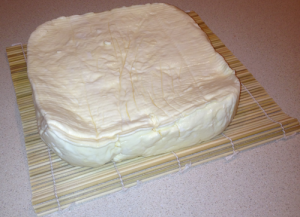
Air Drying the Cheese
Finally, after two hours of brining, I took the cheese out of the brine, and laid it on a bamboo mat to air dry for an hour. By this time, it was 9:30 and I was pretty tired. When (not if) I make this cheese again, I’ll start early in the morning.

Finally, at 10:30 at night the cheese was done. I cut a small slice and tried it. Delicious. Very soft, but it holds its shape. Slightly salty and really really good. Crescenza should be eaten within a week of making, but there is no way I can eat 2 pounds of cheese in a week. I discovered that if I vacuum sealed it, it could last a month. So I did. I have three packages of 1/2 pounds of cheese in vacuum packs and one 1/2 pounds of cheese wrapped in plastic for this week. It melts well and I put a slice of it in my scrambled eggs this morning. Delicious!
This is definitely a cheese I’ll make again. While it took a long time to complete the process, the actual work was fairly easy. Next cheese on my radar is a Halloumi which is a pressed cheese. Which means it’s finally time for me to buy a cheese presser!
Remember that all my cheese recipes come from the book Artisan Cheese Making at Home. Totally recommended!
Related articles

 Crafting Crescenza
Crafting Crescenza